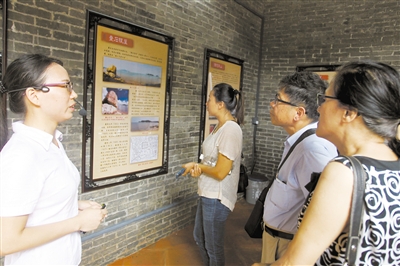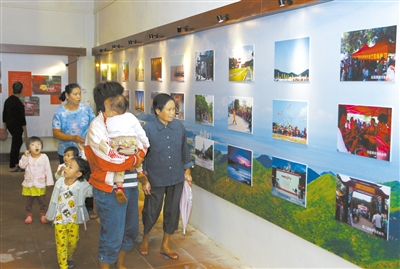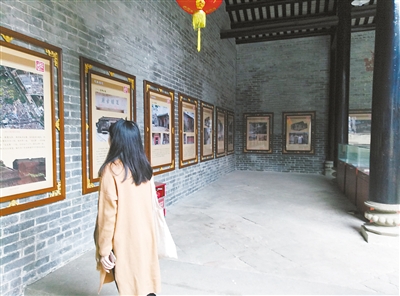 中文PortuguêsEspañolContact Us
中文PortuguêsEspañolContact Us
A showcase for scientific development and higher education, the Zhuhai High-Tech Industrial Development Zone certainly is not disregarding the past. Instead, the Tangjiawan-based leadership has spent heavily renovating century-old key architectures and preserving intangible culture.
As of today, eight village history museums and five intangible cultural heritage inheritance bases have joined the many college campuses and modern New Seaside Technological Town and Headquarters Bases in the zone.

Tour conductor and group at village history museum
The most notable village history museums include Jishan, Qi’ao, and Shangzha. And the fascinating intangible cultural heritage inheritance bases preserve the Jishan Cow Song Mid-Autumn Festival Antiphonal Singing Fair, Qi’ao Dragon Boat Festival Blessings Parade, Tangjiawan Refreshments, Medicated Thread Moxibustion, and Kam Fa Birthday. The museums and bases are all admission-free.
In 2015, the zone completed 18 renovation projects. These include the former residences of Gu Yuan and Lu Muzhen (first wife of Dr Sun Yat-sen), Tangjia Three Temples, Shangzha Yichu Ancestral Hall, and Beisha Lu Duel Ancestral Hall.
The museums display village histories and traditional culture, local folk customs, and changes in living conditions by means of texts, photography, and historic relics and other objects.
The museums are:
Jishan
The Jishan Village History Museum is located at the Jishan Sanfang Ancestral Hall. Built in the Qing Dynasty (1644-1911), the hall has an area of 216 sq m including five rooms and a courtyard. After renovations it reopened on June 8 last year, along with the Jishan Cow Song Mid-Autumn Festival Antiphonal Singing Fair Inheritance Base established there. The history museum presents the evolvement of the village through texts, photographs, and videos. It illustrates the achievements of outstanding locals such as Tang Guoan (Tong Kwo On), the first president of Tsinghua University.
The village is located at the foot of Fenghuang and Jipai mountains overlooking the vast Lingding Sea. Old shrines are distributed throughout the village, to the east of which are various western-style buildings, and to the west are pristine old dwellings with typical Lingnan-style black bricks and gray tiles.
Qi’ao
The Qi’ao Village History Museum and Qi’ao Dragon Boat Festival Blessings Parade Inheritance Base are preserved in the Qi’ao Zhong Great Ancestral Hall (construction date unknown). The museum is 12.58 m wide and 27.17 m deep with a total area of 378.59 sq m. Renovations began in 2015 and it opened on Oct 11 last year. The center exhibits Qi’ao Village through geography, history, culture, origin, events, figures, and today’s new look.

Qi’ao Village History Center
Qi’ao Village on Qi’ao Island was officially named in 1684. It boasts profound history and a rich culture. Its celebrated inhabitants included eminent historical figures such as Zhong Bao, a guerrilla warfare general who had followed Qing Admiral Shi Lang (the General Who Maintains Peace on the Seas) in bringing Taiwan back under the Chinese fold; and Su Zhaozheng, an early-phase leader of the Communist Party of China who also led the General Strike of Hong Kong's Seamen in 1922 and the Great Hong Kong General Strike in 1925.
Qi’ao also has historical sites such as Baishi Street, a monument to celebrate victory over British aggression, folk activities such as the provincial-level intangible cultural heritage Dragon Boat Festival Blessings Parade, and folk craft like the municipal-level intangible cultural heritage Silver Shrimp Paste.
Beisha
The Beisha Village History Museum is situated in the Beishan Lu Ancestral Hall in Xiabei Village of Tangjiawan Town. The ancestral hall built in 1904 has a total building area of 1,599 sq m. It encompasses two family shrines each with a main building, forecourt, wing-room, and outbuilding. The large-scale exquisite architecture offers physical data for the study of ancestral hall culture in Zhuhai and the history of the Lu Family.
The history museum showcases the village’s origin, historical evolution, family history, historical figures, cultural relics, today’s Beisha, and Lu clan laws and teachings. It has not only become an education base, but also a rural tourist attraction.
Huitong
The Huitong Village History Museum is in the Mok Great Ancestral Hall, which was built in the Qing Dynasty. It covers 836.7 sq m with a width of 18.43 m and depth of 45.4 m. The museum displays the village’s development, Mok family history, and outstanding figures via documents, nearly 100 photographs, and more than 20 objects that show comprador culture, integration of land and maritime cultures, village construction, and the modern history of Zhuhai.
Huitong Village is north of Fenghuang Mt at the foot of Ligang Mt, not far from the Beijing Institute of Technology Zhuhai Campus. The old village embodies how an unstable society fared over two centuries.
Shangzha
The Shangzha Village History Museum is in the Shangzha Yichu Ancestral Hall, which was built in 1895. Shangzha Village is located in Jinding Town at the border of Zhuhai and Zhongshan. The original Chongjing Hall was set up by wealthy tea merchant Lu Fuhua to commemorate his late father, Lu Yichu. The 576-sq-m hall features well-preserved wood carvings in various shapes and exquisite craftsmanship. The museum presents the village in terms of evolution, socio profiles, surname headstream, cultural relics, and remarkable figures.
Shangzha villagers have shown respect for culture and education over the centuries. It was full of book houses and old-style private schools early in the Qing Dynasty. The villagers were open-minded due to their proximity to Hong Kong and Macao. Five of local youngsters were sent to study in the US as the first- and second-detachment Chinese Educational Mission (CEM) students during the reign of Emperor Tung Chih (Tongzhi) in the Qing Dynasty. More than 100 locals went to inland cities and Hong Kong, or Japan, and even America and Europe during the late Qing and the Republic of China period.
There are three temples and a bridge built in the Ming Dynasty (1368-1644), and more than 20 ancestral halls built in the Qing Dynasty, 13 of which are listed in the directory of Zhuhai’s immovable cultural relics sites.
Dong’an
The Dong’an Village History Museum is inside the Dong’an Mianshi Building, which was built in 1933. The four-layer main structure is about 440 sq m in a combination of Chinese and Western architectural elements. The museum completely showcases the general situation, origin, and development of the settlement through documents and historic photos.
The village obtained its name because of its location during the Tang and Song dynasties -- shore-side of the Jinxing Watercourse and northeast at the foot of Nanshan Mt. It featured diligent and studious villagers who had made great contributions to the country’s development. Huang Kuan (Wong Foon), for instance, was the first Chinese to study in Europe and the most prominent representative of the village.
Tourist attractions such as Dong’an Community and Zhongshan Park appeal to overseas and domestic tourists and renowned enterprises such as Meizu Technology Co Ltd.
Guantang
The Guantang Village History Museum is in Xiangzhu Temple, also dubbed Shengtang Temple. The 131.3-sq-m temple with three rooms and two porches has characteristics of Cantonese traditional architecture. The local government invested to restore the temple in 2015 and established the history museum there. The museum has become a cultural exchange window through exhibitions concerning the origin, geological environment, cultural relics, renowned figures, today’s Guantang, and outlook for the future.
Nazhou
The Nazhou Village History Museum is in the Gu Great Ancestral Hall in Nazhou Village of Tangjiawan Town. Built in 1838 for the earliest ancestor of villagers surnamed Gu, the hall covers an area of 508.1 sq m. The museum was built in 2015 after the comprehensive renovation of the Gu Great Ancestral Hall that year. It displays Nazhou Village from aspects of geological environment, historical development, outstanding figures, cultural relics, and the present time.
Tips
History museums in Jishan, Qi’ao, Nazhou, Shangzha, Beisha, and Huitong open between 9:30 am and 5 pm every Tuesday to Sunday. The Guantang and Dong’an village history museums only open on holidays from 9:30 am to 5 pm.

Photo display of village development [Photos by Cheng Lin / Zhuhai Daily]